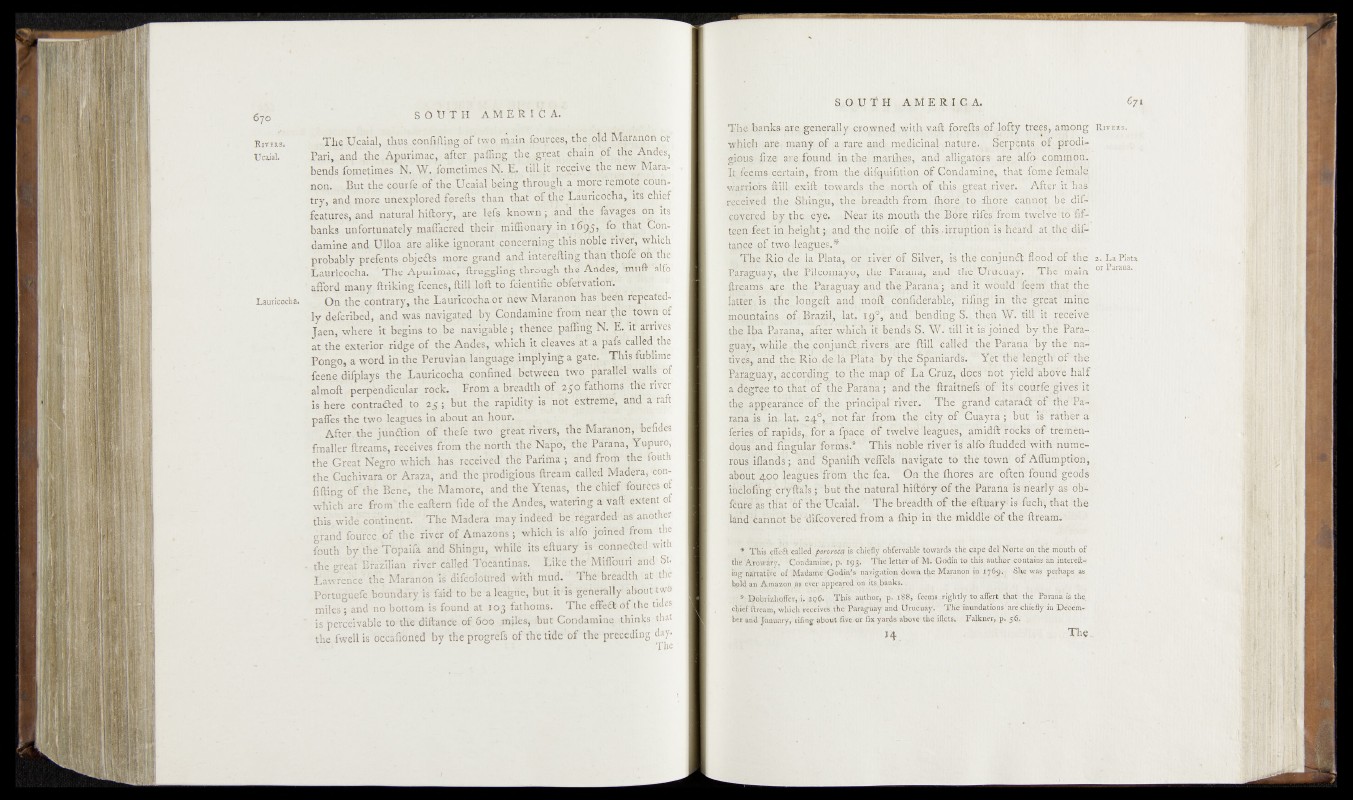
6yo
R ivers.
Ucaial.
Lauricocha.
S Ó Ü T II A M E R I C A.
The Ucaial, thus cönfifting.pftwo. main fpurces, the old Maranoil oi*
Pari, and the Apurimac, after palling the. great chain o f the Andes,
bends fometimes N. W. fometimesN. E. till it receive the new Maranon.
But the courfe of the Ucaial being through a moré remote country,
and more unexplored ferefts than that óf the Lauricocha, its chief
features, and natural hiftory, are lefs known, and the favages on its
banks unfortunately maflacred their'mriffioriary in 169^, fo that^Con-
damine and Ulloa aTe alike ignorant concerning this noble fiver, which
probably prefents objects more' grand and intefeftirjg than thófe on the
Lauricocha. The Apurimac, ftruggling through the Andes, muft alfo
afford many ftriking fcenes, ftill loft to fcientific obfervatiou.
On the contrary, the Lauricocha or hew Maranon has been repeatedly
defcribed, and was navigated by Condamine from .neaif the town óf
Jaen, where if begins to be navigable ;, thence^ paffing N. rE.^rfcii^s
at the exterior ridge of the Andes, which it cleaves^1 a*^al^calK'fhe
Pongo, a word in the Peruvian- language implyini; a This
fcene difplays the'Laujricocha confined between 'wïflls“bf
almoft perpendicular rock. From a breadth of 2^i?JafnoAs^|l ri^er
is here contraded to "25 ; but the rapidityis noj;‘é|fireïüé, anffaM
paffes.-the two leagues in about an hour. , ? '
After the junction of thefe two great rivers, the Maranon, hefides
fmaller ftreams, receives from the north the Napo, the Parana, Yupuio,
the Great Negro .which has received the Panina ; and from the Youth
the. Cuchivara or Araza, and the prodigious ftream called Madera, con-
fifting of thé Bené, the Mamore, and the Ytenas, the chief fourèes of
which are from the eaftern fide of the Andes, watering a v a l extent of
this widé' continent.; The Madera may'indeed be regarded’ as another
grand foufce o f the river of Amazons ; which is alfo joined from the
fouth b y 'thé Tópaifa arid Shingu, while its eftuary is connected with
the great Brazilian river called Tocantina's. Like |h e Miffomi .and St.
Lawrence 'the klarririon is difcölöured‘ with mud. ' The breadth .at the
. Pdrtuguefe boundary is faid to he'a league, but i f is generally about .two
miles ; and no bottom is found at 103 fathoms. The effedt of the tides
, is 'perceivable to the diftancte.of. óop .miles*-.but Condamine thinks'that
the fwell is öccafiöned by the progrefs of the tide of the preceding chf-
The
S,.0 UTH A. ME R Ml A. 671
The banks are generally cro.wned with vaft forefts of lofty trees, among
which are many of a rare arid medicinal nature. Serpents of-prodigious,
fi/.e are, found in the marlhes, .and alligators are alfo common.
It feems certain, from the. difquifition of Condamine, that Lome female
warriors ftill exift towards the north of this great river. After i t ‘has
received the Shingu, the breadth from ftiore to fliore cannot be .dif-
eqvered by the eye. „ Near, its mouth the Bore rifes’fifom twelve to fifteen
feet in height; and the noife of this -irruption is PEeSi'd at the dif-
tance of two .leagues.* |
The Rio de la Plata,, or. river of S ilv e r ^ the conjunct flobd' o f the
Paraguay, the Pilcomayo,, the Parana, and the' Urucuay. The main
ftreams are the Paraguay and the Parana ; arid it would feeiri that the
latter: is the longeft arid !moft confiderable, rifing in lhev great mine
mountains■ o f Brazil, lari’ io°.' arid bending S. then W. till it receive
the Iba Parana, after which it bends S. W. till' it is joined by We Paraguay,
while the conjunri. nvere. are ftill called the Parana by the na-
tivc|j and the Rio.'de/Ja Plata by the Spaniards. Yet tiid-length of the
Paraguay, according -tb'mri riiap o f La Cruz',! does not yield above half
a degree to that of the .Parana ■ ;arid the ftraitnefs o f its courfe. gives it
the appearance of the principal river. The ufrindm|tam<ftJori t^erPa-
ranais mvlari 2 4°,in m Jar from the, city Guiyra fthulm f'rltfilf a
fifties o f rapids,, for a fpace o f t'welve^ea^he^^m^ft'foclcs o f tfremen-
aous arid fingulaf1ferrns.9 This Abble river ¥s alfb'ftridded'hvffh riutrfe-
rom iflanSs ; and Spanilh veffela 'riarigate to^fie tdwif o f Affumptitfri5,
a ^ ^ ^ o o T e a g u e s - \ l i e fea. Off’the m fi|e ^ r e -often*fdund gebdt
iltclofinl V ffM s j'b u t thff natural hiffdryjof theTkraria is!rieariy
Icriflls trfat '6f the’Uea'ia’l. ' The breadth o f the Afthar yj is*'-ftcl?,'that fthe
land^anriot be1 riliffcrieredfrom a fhip irf themiddid'bf^he ftream.
R iver s.
2. L a Plat:*
01 Para id.
* This effect Called ppKorodq is chiefly ohfcrvablc towards the cape del Norte on the mouth of
the Arowavy. * Condamine, p. 193-. The letter of M. Godin to this author contains an intereft-.
iiig niOrati.vc o f -Madame jGodin’s navigation down the Maranon ip 1769.. She was perhaps, as
bold an Amazon .as ever appeared on its .banks.. ,
; .■ 9:©ohiizhoffer, i. ,206. This author, p. 188, feems righdy to affgrt that the Parana'is the.
chief ftream, which receives the Paraguay and Uraeuay. * The inundations are chiefly in Decemberarid
January, rifing about five-or fix yards- above the illets. Falknev, p. 56..
m The